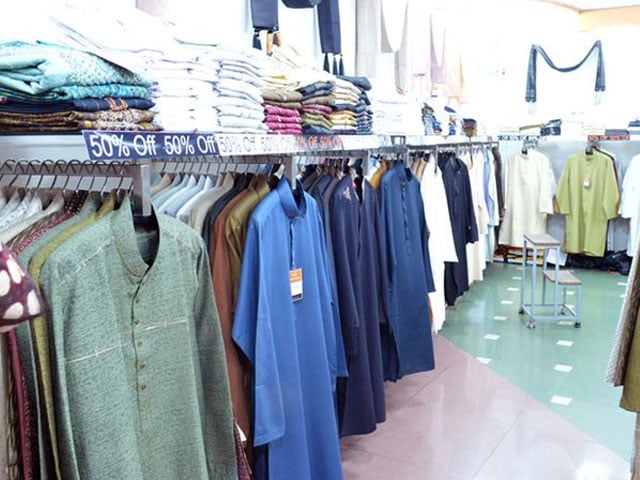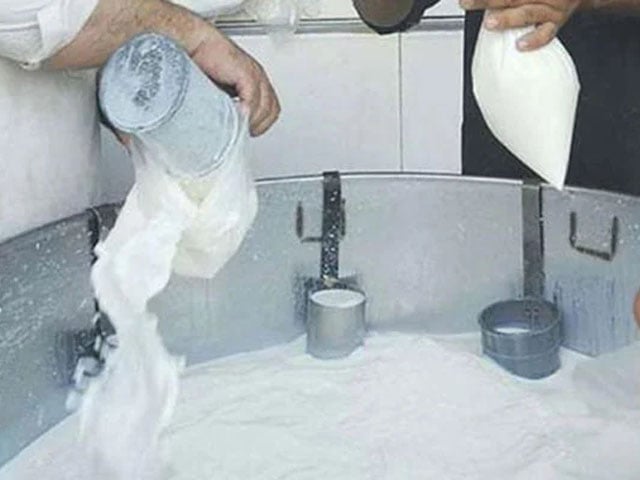Karachi: The effects of inflation are visible on Eid shopping and there is a tendency to reduce the purchase of clothes for new clothes on Eid. The sale of unstitched clothes is limited in men’s clothing sales centers in different areas of Karachi.
Due to increase in the price of cloth and increase in the wages of tailors, most of the citizens are preferring stitched garments, while the buyers of unstitched garments are also buying on a limited scale, which has reduced the traditional splendor of the centers and bazaars that sell clothes. Is.
Men’s clothing sales centers in Karachi are located in Bolton Market, Jama Cloth, Sadar, Landhi, Liaquatabad and Clifton, while clothing is also sold in Bara Markets located in different areas, including Banaras, Paposh, Lasbela, Nazimabad, Bara Markets of Tariq Road are included.
The trend of buying unstitched cloth on Eid and making a couple is decreasing year by year, which is mainly due to the increase in the cost of cloth along with the cost of sewing. This year there is a significant drop in clothing purchases and there is not the usual rush of customers at the clothing centers. Shopping centers for clothes start from Shaban, which has been delayed this year.
Traders in the cloth business say that the depreciation of the rupee has made imported cloth more expensive, while local mills have also increased the price of cloth due to the increase in their costs, while the cost of delivery and transportation of cloth has increased. Also, the increase in business cost during a year is also the reason for the increase in the cost of clothes.
Citizens say that a normal cloth suit costs 2,500 to 3,000 rupees, if it is sewn for 1,500 rupees, then a suit costs 4,000 to 4,500 rupees. While normal sewing pairs are easily available for 2000 to 2500 rupees, then there is no need to buy cloth and get expensive sewing done.
Despite the inflation, cloth buyers say that it is a tradition to sew new pairs on Eid in the year, without which the joy of Eid seems incomplete, so despite the inflation, they sew new pairs according to their purchasing power.
Bara market located in Nazimabad area of Karachi is also called Chawla market where there are large markets for selling men’s clothes, more than 100 shops in these markets sell imported and local clothes including cotton and wash and dry. Includes a variety of ware.
The bazaar is open all night from 10 Ramadan onwards and the shops remain open till Suhoor. The shopkeepers of the market say that due to the inflation this year, the budget of the buyers is low, so they are selling cloth at very low profit.
In this market, cotton suit is being sold for 1800 to 2600 rupees while wash and wear cloth is being sold for 1500 to 2000 rupees.
Compared to last year, the price of cloth has increased by Rs 100 to Rs 150 per meter and a normal six meter suit has increased by Rs 600 to Rs 900 since last year.
Citizens who shop at the market say that this market provides seamless cloth according to every budget and there are no parking problems, so shopping is done with ease.
According to cloth merchants, 60% imported and 40% locally manufactured cloth is purchased for men’s clothing on Eid, foreign cloth is imported from China while local cloth is mostly produced in Kamalia and Faisalabad.
Due to increase in business cost and decrease in sales, no new stock of foreign cloth has been ordered on Eid and limited amount of cloth has been imported, while due to decrease in production of local mills, shortage of good quality local cloth is seen in the markets. While the prices have increased by 30% compared to last year.
On Eid, mostly cotton clothing fabric is bought which is suitable for summer but on normal days most of the shalwar kameez wearers prefer wash and wear fabric which is stronger than cotton and wrinkle resistant. They are also easily removed.
Mostly light colored cloth is preferred depending on the weather of Karachi, young people opt for relatively dark colors. The most sold colors on Eid include white, sky, off-white colors while the dark colors favored by the youth include dark blue, black, brown and biscuit colored clothes.
(function(d, s, id){
var js, fjs = d.getElementsByTagName(s)[0];
if (d.getElementById(id)) {return;}
js = d.createElement(s); js.id = id;
js.src = “//connect.facebook.net/en_US/sdk.js#xfbml=1&version=v2.3&appId=770767426360150”;
fjs.parentNode.insertBefore(js, fjs);
}(document, ‘script’, ‘facebook-jssdk’));
(function(d, s, id) {
var js, fjs = d.getElementsByTagName(s)[0];
if (d.getElementById(id)) return;
js = d.createElement(s); js.id = id;
js.src = “//connect.facebook.net/en_GB/sdk.js#xfbml=1&version=v2.7”;
fjs.parentNode.insertBefore(js, fjs);
}(document, ‘script’, ‘facebook-jssdk’));


